This study compares invasive and non-invasive pulse wave indices for detecting significant coronary artery disease (CAD) using reflection index (RI) and stiffness index (SI). Among 56 patients, non-invasive methods showed significant differences in RI and SI between CAD and no-CAD groups, but did not correlate with the severity of CAD, while invasive methods did show significant correlation. The findings suggest non-invasive pulse wave assessment is useful for CAD detection, although may not effectively predict CAD severity.
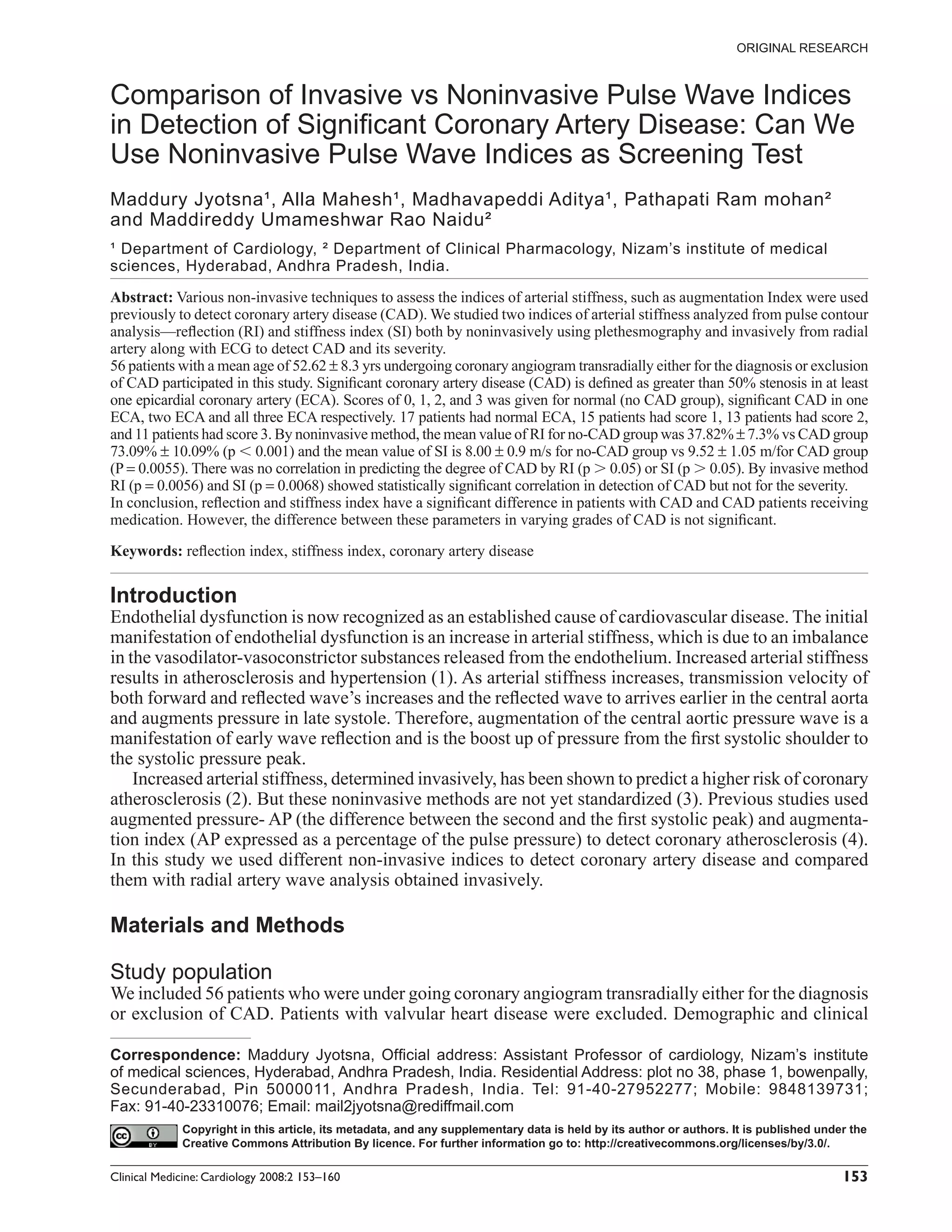
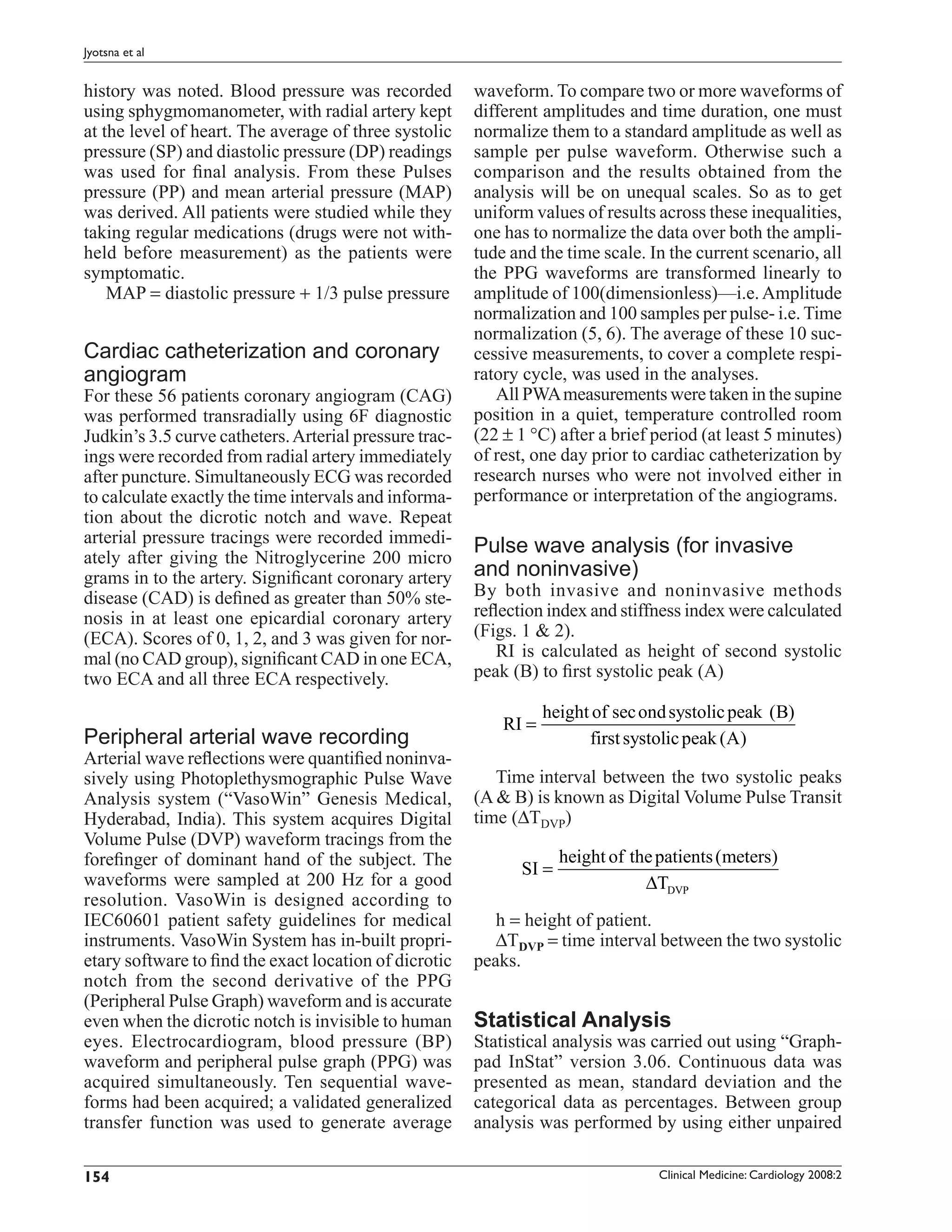
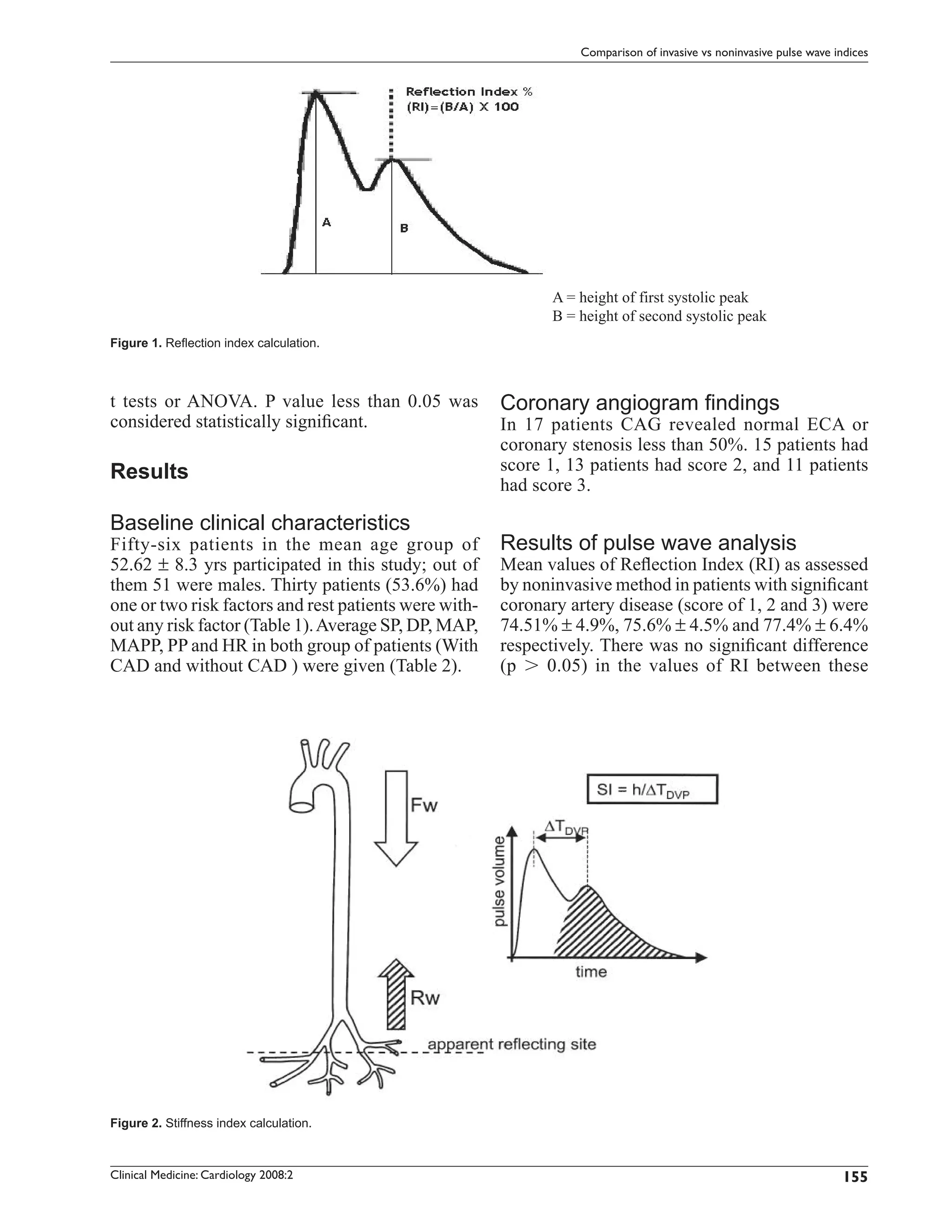
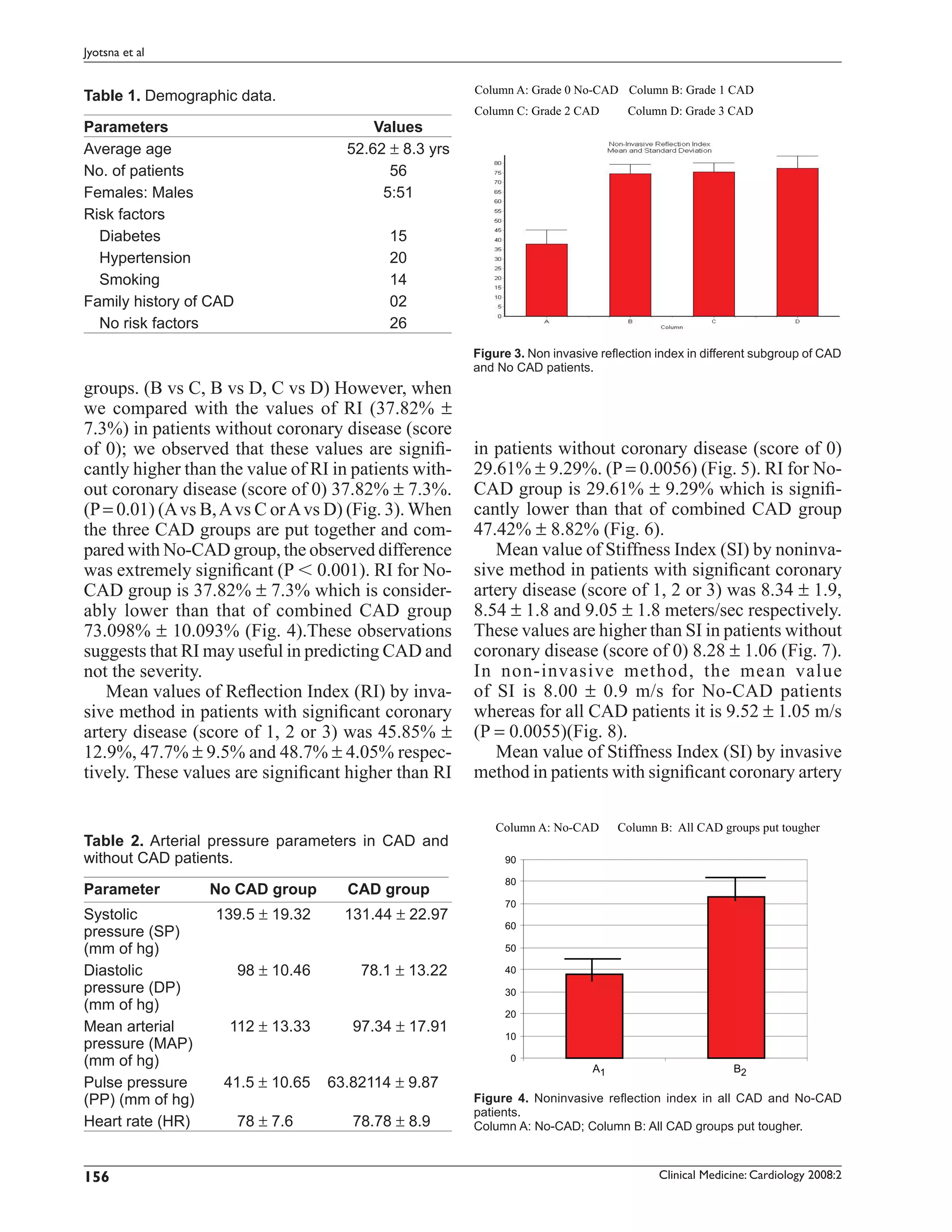

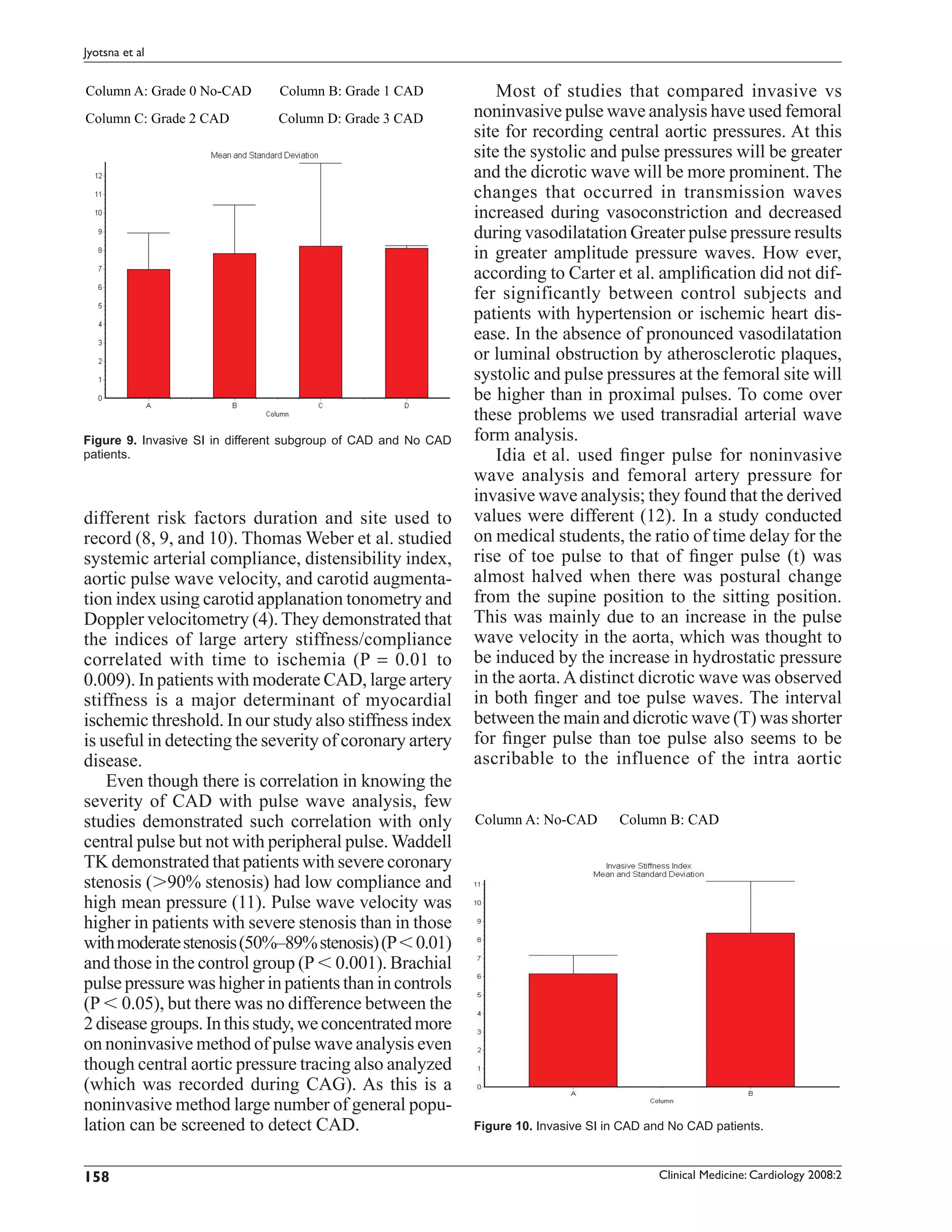
![Comparison of invasive vs noninvasive pulse wave indices
Figure 11. Correlation of SI invasively and noninvasively.
pressure: pulse was transmitted faster in the that the patients were continued medications pre-
systolic phase than in the diastolic phase. The scribed for CAD, which will have effect on these
features of pulse waves of hypertensive patients indices (14, 15).
were that time delay for the rise of pulse (t) was
short even in the supine position, and the dicrotic
wave was small or absent especially for toe pulse. Conclusion
In present study we used finger pulse and radial The values of noninvasive pulse wave indices,
arterial pulse and observed that the non invasive reflection index and stiffness index, were signifi-
pulse wave indices may useful in predicting CAD cantly different in patients without CAD and CAD
and not the severity. McLeod AL intravascular patients under medication. This difference may be
ultrasound guided study also did not demonstrate higher if the patients were not under medication.
the good correlation with these indices derived However, the difference between these parameters
from the noninvasive pulse wave analysis with the in varying grades of CAD is not significant. This
severity of CAD (13). may indicate that though these parameters may be
One potential limitation of our study is the used for differentiation between patients without
confinement to symptomatic patients referred for CAD and CAD patients, their potential to indicate
coronary angiography. Many of them had athero- the degree of CAD may be limited.
sclerotic obstructive CAD and very few had normal
luminogram. However, the incidence of normal References
epicardial vessels varies between 10%–25% of total [1] O’Rourke, M.F. and Mancia, G. 1999. Arterial stiffness. J. Hypertens,
number of angiograms. To get significant number 17:1–4.
[2] Kingwell, B.A., Waddell, T.K., Medley, T.L., Cameron, J.D. and Dart,
of cases with normal epicardial vessels, we have A.M. 2002. Large artery stiffness predicts ischemic threshold in
to screen large number of patients. Getting asymp- patients with coronary artery disease. J. Am. Coll. Cardiol.,
tomatic subjects for invasive studies is not practi- 40(4):773–9.
cal. However, it seems very much possible that our [3] Kuvin, J.T., Patel, A.R., Sliney, K.A., Pandian, N.G., Sheffy, J.,
Schnall, R.P., Karas, R.H. and Udelson, J.E. 2003. Assessment of
findings may be reproduced in large scale studies peripheral vascular endothelial function with finger arterial pulse
of this milieu. Another limitation of the study was wave amplitude. Am. Heart J., 146(1):168–74.
Clinical Medicine: Cardiology 2008:2 159](https://image.slidesharecdn.com/pulsewaveindice-100604162331-phpapp01/75/Pulse-wave-indice-7-2048.jpg)
![Jyotsna et al
[4] Thomas Weber, M.D., Johann Auer, M.D., Michael, F., O’ Rourke, [10] Pierre Boutouyrie, Anne Isabelle Tropeano, Roland Asmar, Isabelle
M.D., Erich Kvas, ScD., Elisabeth Lassing, M.D., Robert Berent, Gautier, Athanase Benetos, Patrick Lacolley and Stephane Laurent.
M.D. and Bernd Eber, M.D. 2004. Arterial Stiffness, Wave reflec- 2002. Aortic Stiffness Is an Independent Predictor of Primary Coro-
tions, and the risk of coronary artery disease. Circulation, nary Events in Hypertensive Patients. A Longitudinal Study. Hyper-
109:184–9. tension, 39:10–15.
[5] Applied functional data analysis: methods and case studies, Ramsay, [11] Waddell, T.K., Dart, A.M., Medley, T.L., Cameron, J.D. and Kingwell,
J.O. and Silverman, B.W. 2002. Springer series in statistics, New B.A. 2001. Carotid pressure is a better predictor of coronary artery
York, London: SpringerISBN:0–387–95414–7. disease severity than brachial pressure. Hypertension, 38(4):927–31.
[6] Functional Data Analysis, Ramsay, J.O. and Silverman, B.W. Copy- [12] Iida, N. and Iriuchijima, J. 1992. Postural changes in finger and toe
right# 2001 Elsevier Science Ltd. International Encyclopedia of the pulse waves. Kokyu To Junkan, 40:981–6.
Social and Behavioral Sciences ISBN:0–08–043076–7. [13] McLeod, A.L., Uren, N.G., Wilkinson, I.B., Webb, D.J., Maxwell,
[7] Murray, W.B. and Foster, P.A. 1996. The peripheral pulse wave: S.R. and Northridge newby, DE. 2004. Non-invasive measures of
information overlooked. Clin. Monit., 12:365–77. pulse wave velocity correlate with coronary arterial plaque load in
[8] Mitchell, G.F., Parise, H., Benjamin, E.J., Larson, M.G., Keyes, M.J., humans. J. Hypertens., 22:363–8.
Vita, J.A. and Levy, D. 2004. Changes in arterial stiffness andwave [14] Hope, S.A. and Hughes, A.D. 2007. Drug effects on the mechanical
reflection with advancing age in healthy men and women: the Fram- properties of large arteries in humans. Clin. Exp. Pharmacol. Physiol.,
ingham Heart Study. Hypertension, 43:1239–45. 34(7):688–93.
[9] Millasseau, S.C., Kelly, R.P., Ritter, J.M. and Chowienczyk, P.J. 2002. [15] Ting, C.T., Chen, C.H., Chang, M.S. et al. 1995. Short and long term
Determination of age-related increases in large artery stiffness by effects of antihypertensive drugs on arterial reflections, compliance
digital pulse contour analysis. Clinical Science, 103:371–7. and impedance. Hypertension, 26:524–30.
160 Clinical Medicine: Cardiology 2008:2](https://image.slidesharecdn.com/pulsewaveindice-100604162331-phpapp01/75/Pulse-wave-indice-8-2048.jpg)